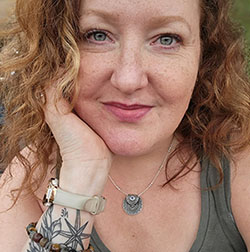Now here we are, nearly present time: In January 2024, I came within hours of losing my life.
I was hospitalized with sepsis, a silent and brutal enemy I never saw coming. I ended up with a 9cm abscess on my spinal cord, requiring emergency surgery. What I thought was just another bout of exhaustion turned into two months between the hospital and rehab, followed by six more months of fighting to regain feeling in my back, to walk without pain, to exist in a body that had betrayed me. I don’t want to be melodramatic about it, but there’s no other way to say it: I almost didn’t make it.
And yet, here I am.
I spent those months in sterile rooms, where everything was beige and fake wood and hard and impersonal. There was no warmth, no softness, no color—no design meant for actual humans, only for function. The walls held nothing of me, nothing of life, and I realized how deeply I had come to believe in the power of space to heal. Because in those hospital beds, in those stark rooms, I had never felt further from myself.
When I finally made it home, I saw my space differently. The work I had done over the years to make my home a place of peace, comfort, and identity was the difference between feeling lost and feeling like I had somewhere to land. The art, the light, the layers of warmth—they weren’t just design choices anymore. They were survival. Even now, I remember the deep bear hug my home gave me upon my return, and it restored my soul.
Taking It to the World
That’s when I knew: this work isn’t just about me.
I’ve always understood the emotional power of home design, but coming out of that experience, I saw it on a new level. I knew what it meant to need a space that supports healing. I knew what it felt like to return home after a battle I wasn’t sure I’d win and to be held by the walls around me.
So I took what I learned and brought it into my work. I stopped second-guessing whether what I had to say mattered. I started sharing my story, because I knew I wasn’t alone in this—so many people are trying to find their way back to themselves, and their homes can either help or hold them back. I wanted to be part of helping people create spaces that give back, that offer rest, that remind them who they are.
A Woman in Business, Owning Her Story
There is an unspoken expectation that women, especially in business, should present themselves as put-together, in control, unwavering. But here’s the truth: I have built something meaningful not despite what I’ve been through, but because of it.
My experiences—quarantine, survival mode, grief, near-death, rebuilding—have made me a better designer, a better business owner, and a better advocate for the people I work with.
This work isn’t just about aesthetics. It’s about resilience, about shaping spaces that don’t just look good but do good—for your body, your mind, your well-being.
What Comes Next?
Now, my work is bigger than just design. It’s about helping others reclaim their spaces the way I had to reclaim mine—one small decision at a time, one shift toward comfort, one piece of art on the wall that reminds you who you are and where you came from.
Next time, I’ll talk about the little things—how tiny, intentional design choices can create threads of hope when everything else feels impossible. Because even in the hardest moments, your home can be a lighthouse. You just have to let it.
Until next time—when I talk about the quiet ways design can whisper, you are still here.
Because I do, every day. Even with my loud, booming, Scot warrior voice.
Stay weird, stay wonderful.
Steph

